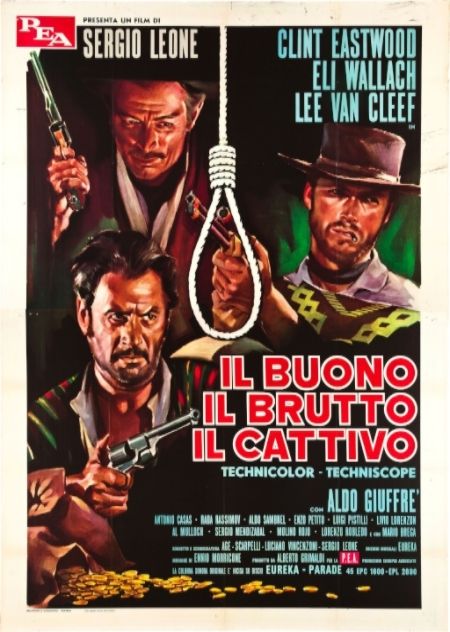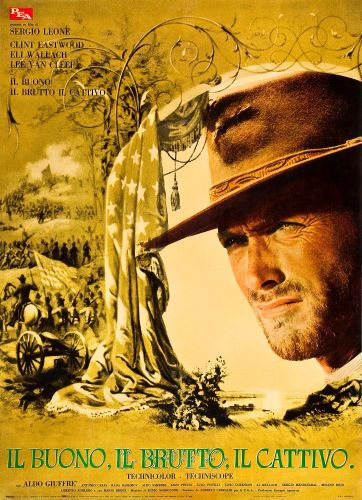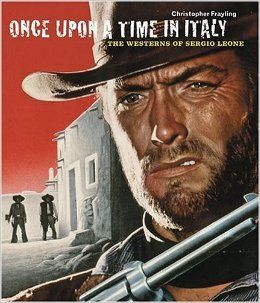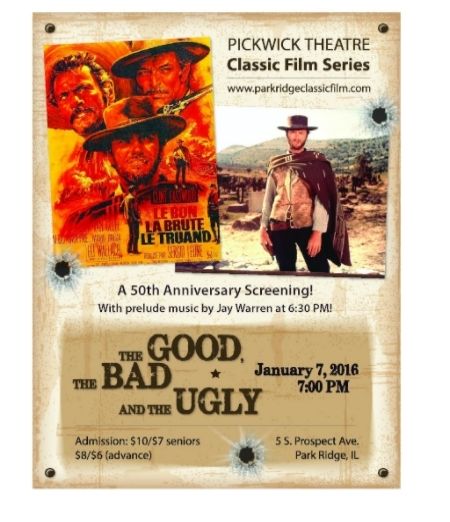WHAT: The Good, the Bad and the Ugly (1966) 50th anniversary
NOTE: We will be screening the restored version on DCP (digital).
WHEN: January 7, 2016 7:00 PM
WHERE: Pickwick Theatre, Park Ridge, IL
WHAT ELSE: Organist Jay Warren performs prelude music beginning at 6:30 PM
HOW MUCH: $10/$7 (seniors 60+) or $8/$6 (advance)
Texas, 1862: Three gunslingers with shifting loyalties– Clint Eastwood (the good), Lee Van Cleef (the bad), and Eli Wallach (the ugly)– are on the trail of a Confederate treasure. During their pursuit of the hidden gold, they get caught up in the turmoil of the Civil War.
Director Sergio Leone’s The Good, the Bad and the Ugly (1966) is one of the most anticipated films in our upcoming 2016 schedule. The Pickwick Theatre Classic Film Series will be screening the film in honor of its 50th anniversary this year. Over the past fifty years, GBU‘s impact on pop culture and in film history, specifically its influence on contemporary filmmakers, has been profound. Quentin Tarantino, whose new film The Hateful Eight features a score by Ennio Morricone, has called The Good, the Bad and the Ugly his favorite film.
The Good, the Bad and the Ugly is one of three films directed by Sergio Leone that made an international star out of Clint Eastwood. It was their third collaboration following A Fistful of Dollars (1964) and For a Few Dollars More (1965). GBU is the largest and most ambitious of Leone’s “Dollars” trilogy. Though the Italian Westerns– popularly known as “spaghetti Westerns”– had been around before A Fistful of Dollars, this subgenre of the Western is most associated with Sergio Leone. There would be hundreds of these European-made Westerns in the years to follow– a genre that would be internationally popular well into the 1970s before being supplanted by the martial arts film.
Il Buono, Il Brutto, Il Cattivo
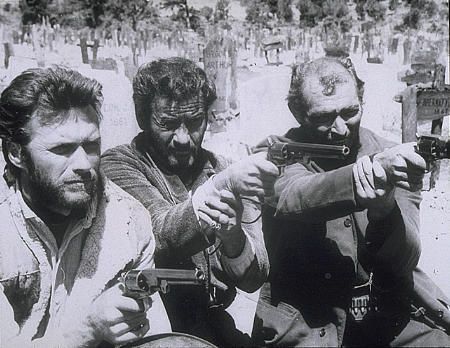
Leone’s style is best exemplified by the opening shots in The Good, the Bad and the Ugly: a wide, semi-barren landscape which suddenly becomes a close-up of a tough-looking character. We see his point of view– a small town– and then we return to the close-ups of him and his partners on the move. The entire film features this pattern of panoramic compositions with intense close-ups. The opening scene is also a great example of Leone’s use of sound, which is a large part of the film’s effect. As was the custom in Italian cinema, all the sound effects were post-synched.
Leone made movies using an epic canvas, allowing his stories to play out at a leisurely pace– unlike modern cinema which fixates on fast edits. His scenes had their own pace, rhythm, and tone. It’s certainly a more brutal, realistic world than the Hollywood Westerns that had inspired Leone, but at their core, Leone’s protagonists– “The Man With No Name”– could be just as mythic.
“I think Sergio Leone will definitely be known as the man who invented the spaghetti Western. Personally, for my money, I think he is the greatest of all Italy’s filmmakers. I would even go as far as to say he is the greatest combination of film stylist– where he creates his own world– with the storyteller part of him as well. These two are almost never married.” ~ Quentin Tarantino
Spain substitutes for the American West in The Good, the Bad and the Ugly. It is a picture of America as seen through European eyes. Sergio Leone tried to make his depiction of American history as authentic as possible, having been influenced by the photographs of Civil War photographer Matthew Brady. The scenes of war, which Leone claimed were inspired by a little-known skirmish in Texas, show the true spectacle of his vision. The film features large-scale battle sequences including a scene in which a disputed bridge is blown up. These sequences are essential to Leone’s theme, showing the larger violence and waste playing out around the three main characters.
Director Sergio Leone with star Clint Eastwood
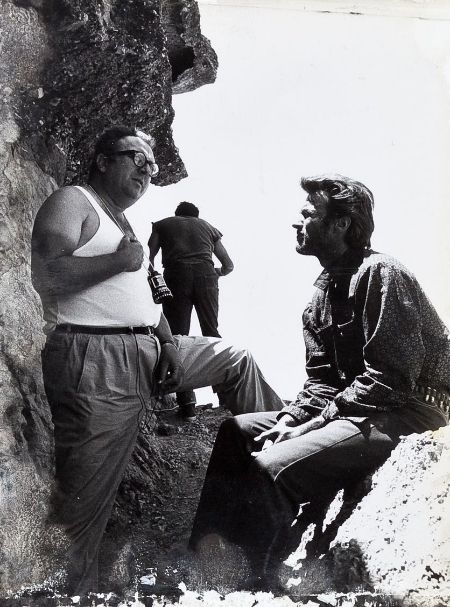
One of the most iconic images in cinema history– Clint Eastwood in his poncho.
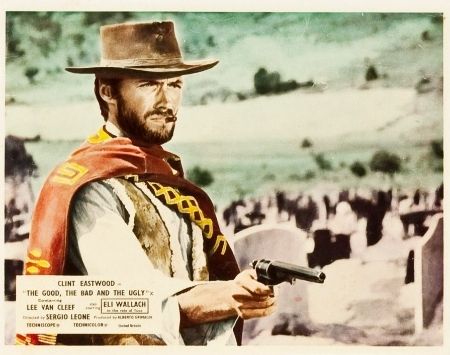
The great Italian composer Ennio Morricone scored The Good, the Bad and the Ugly– one of his most recognizable film scores in a career that has spanned seven decades and hundreds of films. Morricone is still going strong at the age of eighty-seven, having most recently contributed to Quentin Tarantino’s The Hateful Eight (2015).
His score for GBU is one of the best in film history, from the coyote-like howl of its main title to the lyrical choral effects. Ennio Morricone’s method was to compose the themes first. His “Ecstasy of Gold,” which is heard during the climactic cemetery sequence, was written first before anything had been filmed. Leone then shot and edited the movie to conform with the rhythm of the score. It is truly one of the great examples of image and music working together.
Morricone said of this scene, “Those three minutes and twenty seconds are a cinematographic moment of enormous expressivity– but also great editing techniques, great camera techniques, and a great way to think out a scene. Also, I must say, the music did its part…”
The Good, the Bad and the Ugly is masterful filmmaking done on a large scale. Though critics at the time fixated on the film’s violence, they glossed over its great humanity. With his “Dollars” trilogy, Sergio Leone essentially reinvented the Western genre at a time when Hollywood Westerns had become tired and formulaic. Though he did not actually invent the Italian Western, the best of them begin and end with Sergio Leone. His influence can be seen in a whole generation of filmmakers like Quentin Tarantino, Robert Rodriguez, and many others.
For more about Sergio Leone, Christopher Frayling’s Once Upon a Time in Italy: The Westerns of Sergio Leone (2005) is essential reading. Christopher Frayling also provided an outstanding audio commentary on the blu-ray version of The Good, the Bad and the Ugly.
